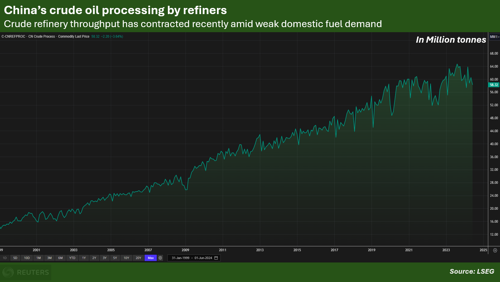Key China energy indicators to track for the rest of 2024
Slower consumption in China spurred the Organization of the Petroleum Exporting Countries (OPEC) to cut estimates for global oil demand growth this week, highlighting the vital role that the world's second largest economy plays in energy markets.
Yet, overall electricity generation in China climbed to new highs in the first half of 2024 - indicating robust use by households and factories - and imports of liquefied natural gas (LNG) rose 10% to the highest in three years.
The country's ongoing efforts to transition energy systems away from polluting fuels towards cleaner power sources can help reconcile some of the conflicting signals, and account for cuts to refined fuel use and rising electricity demand.
But record large thermal coal imports during the first half of 2024 also underscore the enduring challenge facing China's power suppliers, which remain hugely dependent on some fossil fuels even as they cut back consumption of others.
Below are some of the key energy and power sector data points that can help provide a gauge of China's appetite for fossil fuels going forward, and the potential impact on world markets.
Oil cuts. The main high-level measure of China's oil demand is the country's imports of crude oil, as China imports roughly 75% of its total oil needs and is the world's largest crude purchaser.
China's imports in July fell to their lowest since September 2022, as weak processing margins and low fuel demand curbed operations at state-run and independent refineries.

The world's largest crude oil buyer brought in 42.34 metric MMt in July, or about 9.97 MMbpd, data from the General Administration of Customs showed.
That import total was nearly 12% below the prior month and around 3% below the year-before tally, and so dealt a blow to oil market bulls who may have been hoping for sustained growth in China's oil purchases.
However, analysts who have been tracking more granular data on China's refinery throughput and domestic production will have already been aware of the weak tone of the country's oil use.

Additional detail can also be discerned by the implied direction of the country's oil reserves, which can be estimated by subtracting domestic output and refinery processing levels from total imports over a given time.
The recent stretch of softening crude refinery processing data suggest that China's oil inventories have likely been climbing for several weeks, and so in turn will have tempered demand for imports.
Going forward, any sustained drawdown in those oil stockpiles could herald a change in China's import appetite, and potentially trigger a sentiment boost in the broader oil market.
Cars, coal and power. Further undermining oil and fuel demand in China lately has been a steady increase in the share of electric and clean energy vehicles in the national car fleet.
For the first time, half of all vehicles sold in China in July were either pure electric or hybrid - marking a major milestone in China's efforts to wean consumers off petroleum products.
But while higher sales of EVs and hybrids help to chip away at China's fossil fuel needs, they drive continued growth in the country's electricity demand.
China's total electricity demand climbed by 32% between 2018 and 2023, according to energy think tank Ember, to 9,442 terawatt hours (TWh) and the highest in the world.
That growth rate is over 2.5 times the global average, and compares to just 1% growth in electricity demand in the United States over the same period.
Coal remains the primary source of electricity, accounting for around 60% of total generation, and total coal-fired generation has scaled new highs for the past 8 years.
However, coal's share of the generation mix has declined steadily over the past decade, while generation from clean sources has increased from around 22% in 2013 to over 35% in 2023.
Further expansions in clean generation capacity are planned which will cement China's status as by far the world's largest producer of clean power, even as the country also holds the status of the top global coal consumer.
Growth in natural gas-fired generation is also expected, driven by both higher local gas production and higher imports of liquefied natural gas (LNG).
Through the first half of 2023, LNG imports were 38 metric MMt, according to ship tracking data from Kpler. That total is up 10.1% from the same period in 2023 and is the highest since the opening half of 2021.
Seasonal flows data from LSEG show that LNG imports tend to decline after the summer months as demand for cooling systems drops.
But gas demand should crank up again ahead of the coldest months of the year, and could help push China's annual LNG import totals to new highs for 2024 as a whole.
Coal use and imports tend to follow similar swings, but power firms may opt to reduce coal-fired generation in favor of more gas-fired output if global gas prices remain relatively stable and competitive with imported coal.






Comments